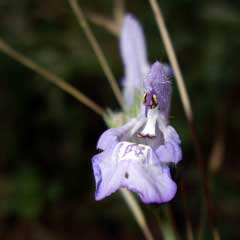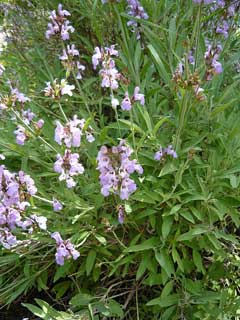 |
|
www.flickr.com/photos/79667341@N00 |
 |
| http://commons.wikimedia.org/wiki/User:Cillas |
Translate this page:
Summary
Physical Characteristics

 Salvia lavandulifolia is an evergreen Shrub growing to 0.3 m (1ft) by 0.5 m (1ft 8in).
Salvia lavandulifolia is an evergreen Shrub growing to 0.3 m (1ft) by 0.5 m (1ft 8in).
See above for USDA hardiness. It is hardy to UK zone 5. It is in leaf all year, in flower in July. The species is hermaphrodite (has both male and female organs) and is pollinated by Insects.
Suitable for: light (sandy) and medium (loamy) soils and prefers well-drained soil. Suitable pH: mildly acid, neutral and basic (mildly alkaline) soils. It cannot grow in the shade. It prefers dry or moist soil.
UK Hardiness Map
US Hardiness Map
Synonyms
S. hispanorum. Lag.
Plant Habitats
Woodland Garden Sunny Edge; Cultivated Beds;
Edible Uses
Edible Parts:
Edible Uses: Condiment Tea
The aromatic leaves are used as an adulterant for the common sage[177, 183]. They are used as a substitute for sage in commercial food flavourings[238]. A sage-like tea is made from the dried leaves[238]. The plant is a source of an essential oil that is used commercially to flavour ice cream, sweets, baked goods, chewing gum, soft drinks etc[183, 238].
References More on Edible Uses
Medicinal Uses
Plants For A Future can not take any responsibility for any adverse effects from the use of plants. Always seek advice from a professional before using a plant medicinally.
Alterative Antiseptic Astringent Depurative Digestive Expectorant Febrifuge Tonic
The leaves are alterative, antiseptic, astringent, depurative, digestive, expectorant, febrifuge and tonic[238]. They are used internally in the treatment of digestive and respiratory complaints, menstrual problems, infertility, nervous tension and depression[238]. This remedy should not be prescribed to pregnant women[238]. The leaves can be harvested as required and used fresh, or they can be harvested before the flowers open and dried or distilled for their essential oil[238].
References More on Medicinal Uses
The Bookshop: Edible Plant Books
Our Latest books on Perennial Plants For Food Forests and Permaculture Gardens in paperback or digital formats.

Edible Tropical Plants
Food Forest Plants for Hotter Conditions: 250+ Plants For Tropical Food Forests & Permaculture Gardens.
More

Edible Temperate Plants
Plants for Your Food Forest: 500 Plants for Temperate Food Forests & Permaculture Gardens.
More

More Books
PFAF have eight books available in paperback and digital formats. Browse the shop for more information.
Shop Now
Other Uses
Essential
The essential oil obtained from the leaves is used in perfumery and to perfume soaps and cosmetics[238].
Special Uses
Scented Plants
References More on Other Uses
Cultivation details
Requires a light well-drained soil in a sunny position[182, 200]. Soils rich in nitrogen encourage excessive leaf growth at the expense of flowering[11]. This species is not hardy in the colder areas of the country, it tolerates temperatures down to between -5 and -10°c[200]. It is as hardy as common sage, S. officinalis[182], to which it is closely related[11]. Plants can be killed by excessive winter wet[200]. The leaves have a pungent lavender scent[182]. Members of this genus are rarely if ever troubled by browsing deer[233].
References Carbon Farming Information and Carbon Sequestration Information
Temperature Converter
Type a value in the Celsius field to convert the value to Fahrenheit:
Fahrenheit:
The PFAF Bookshop
Plants For A Future have a number of books available in paperback and digital form. Book titles include Edible Plants, Edible Perennials, Edible Trees,Edible Shrubs, Woodland Gardening, and Temperate Food Forest Plants. Our new book is Food Forest Plants For Hotter Conditions (Tropical and Sub-Tropical).
Shop Now
Plant Propagation
Seed - sow March/April in a greenhouse[200]. Germination usually takes place within 2 weeks. Prick out the seedlings into individual pots when they are large enough to handle and plant them out in early summer. In areas where the plant is towards the limits of its hardiness, it is best to grow the plants on in a greenhouse for their first winter and plant them out in late spring of the following year. Cuttings of half-ripe wood succeed at almost any time in the growing season[200].
Other Names
If available other names are mentioned here
Native Range
EUROPE: Spain, France (south) AFRICA: Algeria (north), Morocco
Weed Potential
Right plant wrong place. We are currently updating this section.
Please note that a plant may be invasive in one area but may not in your area so it's worth checking.
Conservation Status
IUCN Red List of Threatened Plants Status :

| Related Plants
|
| Latin Name | Common Name | Habit | Height | Hardiness | Growth | Soil | Shade | Moisture | Edible | Medicinal | Other |
| Cistus salviifolius | Rock Rose, Salvia cistus, Sage Leaf Rock Rose | Shrub | 0.6 |
8-11
| F | LM | N | DM | 1 | 0 | 3 |
| Salvia apiana | White Sage, Compact white sage | Perennial | 3.0 |
7-10
| M | LM | N | DM | 3 | 1 | 3 |
| Salvia ballotaeflora | | Annual | 0.0 |
-
| | LM | N | DM | 1 | 0 | |
| Salvia carduacea | Thistle Sage | Annual/Perennial | 0.7 |
7-10
| | LM | N | DM | 2 | 0 | |
| Salvia carnosa | Purple Sage | Shrub | 0.8 |
6-9
| | LM | N | DM | 1 | 2 | |
| Salvia clevelandii | Blue Sage, Fragrant sage, Chaparral Sage | Shrub | 0.6 |
8-11
| M | LM | N | DM | 1 | 0 | 2 |
| Salvia columbariae | Chia, Ziegler's sage | Annual/Perennial | 0.7 |
6-9
| | LM | N | DM | 3 | 2 | |
| Salvia dorisiana | Sage Fruity Pineapple | Perennial | 1.3 |
9-12
| F | LMH | SN | M | 3 | 0 | 3 |
| Salvia dorrii | Purple Sage | Shrub | 0.6 |
5-9
| F | LM | N | DM | 3 | 2 | 3 |
| Salvia elegans | Pineapple Sage, Pineapple-scented Sage, | Perennial | 1.0 |
8-11
| M | LM | N | DM | 3 | 1 | 3 |
| Salvia fruticosa | Greek Sage, Greek oregano | Shrub | 1.0 |
8-11
| M | LM | N | DM | 2 | 3 | 3 |
| Salvia glabrescens | | Perennial | 0.3 |
-
| | LM | SN | DM | 1 | 0 | |
| Salvia glutinosa | Jupiter's Distaff, Sticky Sage | Perennial | 1.2 |
4-8
| | LM | SN | DM | 1 | 0 | 3 |
| Salvia hispanica | Mexican Chia, Chia | Annual | 1.0 |
8-11
| M | LM | N | DM | 3 | 0 | 2 |
| Salvia japonica | | Perennial | 0.8 |
7-10
| | LM | SN | DM | 1 | 0 | 2 |
| Salvia lanata | | Perennial | 0.3 |
6-9
| | LM | N | DM | 1 | 1 | |
| Salvia lanigera | Wrinkle-Leaved Sage | Shrub | 0.0 |
-
| | LM | N | DM | 1 | 0 | |
| Salvia leucantha | Mexican Bush Sage | Shrub | 1.2 |
8-10
| F | LMH | N | M | 0 | 1 | 3 |
| Salvia lyrata | Cancer Weed, Lyreleaf Sage | Perennial | 0.6 |
4-9
| M | LM | N | DM | 0 | 2 | 0 |
| Salvia mellifera | Californian Black Sage | Shrub | 2.0 |
7-10
| | LM | N | DM | 1 | 2 | |
| Salvia microphylla | Blackcurrant Sage | Perennial | 1.2 |
7-10
| | LM | N | DM | 2 | 2 | |
| Salvia moorcroftiana | | Perennial | 0.9 |
6-9
| | LM | N | DM | 1 | 1 | |
| Salvia multicaulis | | Shrub | 0.3 |
7-10
| | LM | N | DM | 1 | 0 | |
| Salvia multiorrhiza | Dan Shen | Perennial | 0.6 |
5-9
| | LM | N | DM | 0 | 3 | |
| Salvia officinalis | Sage, Kitchen sage, Small Leaf Sage, Garden Sage | Shrub | 0.6 |
5-10
| M | LM | N | DM | 4 | 5 | 5 |
| Salvia plebeia | | Biennial | 0.5 |
-
| | LM | N | MWe | 1 | 1 | |
| Salvia pomifera | Apple Sage | Shrub | 1.0 |
7-10
| M | LM | N | DM | 2 | 2 | 2 |
| Salvia pratensis | Meadow Clary, Introduced sage | Perennial | 1.0 |
3-7
| | LM | N | DM | 1 | 0 | 0 |
| Salvia reflexa | Mintweed, Lanceleaf sage | Annual | 0.8 |
0-0
| | LM | N | DM | 1 | 0 | 0 |
|
|
Growth: S = slow M = medium F = fast. Soil: L = light (sandy) M = medium H = heavy (clay). pH: A = acid N = neutral B = basic (alkaline). Shade: F = full shade S = semi-shade N = no shade. Moisture: D = dry M = Moist We = wet Wa = water.
Now available:
Food Forest Plants for Mediterranean Conditions
350+ Perennial Plants For Mediterranean and Drier Food Forests and Permaculture Gardens.
[Paperback and eBook]
This is the third in Plants For A Future's series of plant guides for food forests tailored to
specific climate zones. Following volumes on temperate and tropical ecosystems, this book focuses
on species suited to Mediterranean conditions—regions with hot, dry summers and cool, wet winters,
often facing the added challenge of climate change.
Read More
Expert comment
Author
Vahl.
Botanical References
1150200
Links / References
For a list of references used on this page please go here
Readers comment
© 2010, Plants For A Future. Plants For A Future is a charitable company limited by guarantee, registered in England and Wales. Charity No. 1057719, Company No. 3204567.